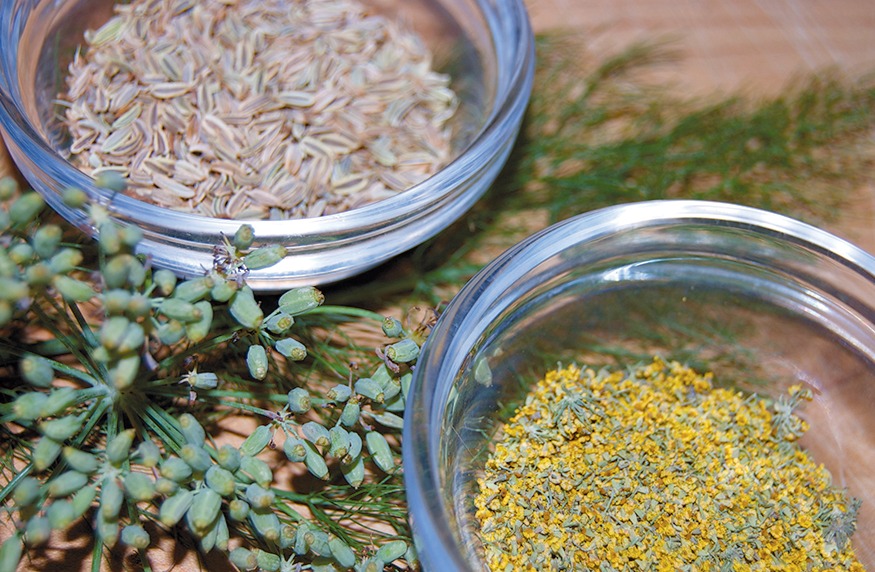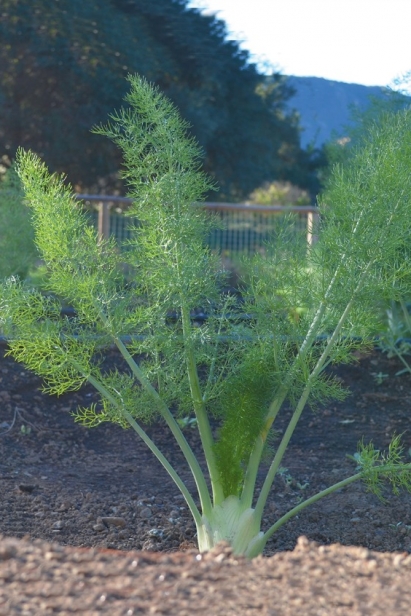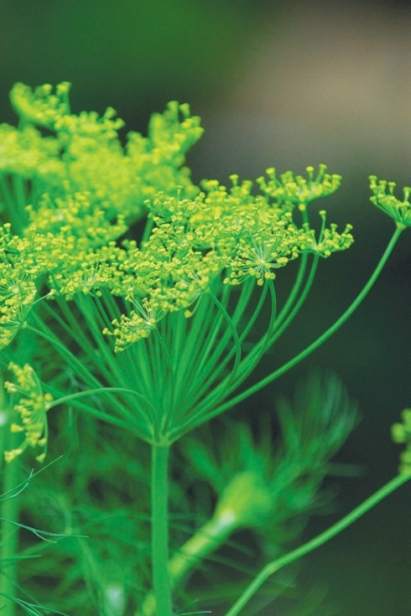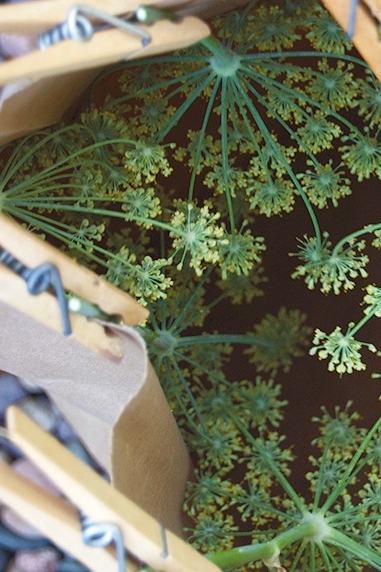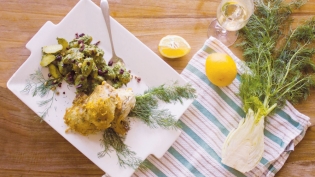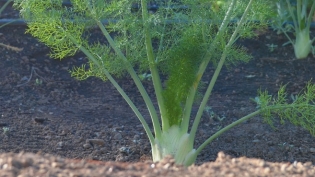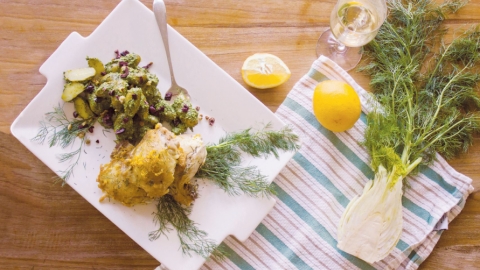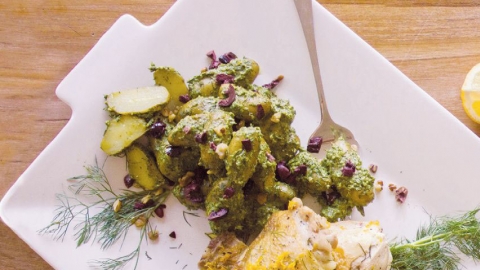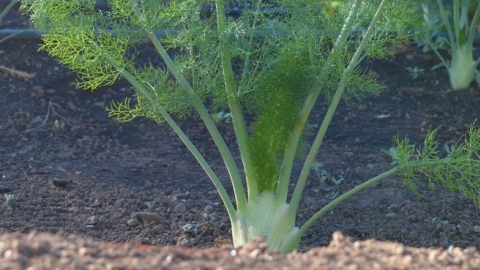Fronds with Benefits: Beautiful, Versatile Fennel Can Be Eaten Bulb to Bloom
A pretty but gangly plant looms over my backyard with all the grace of a construction crane. Unwieldy yet elegant in its coat of feathery fronds, it often gets in the way of my gardening chores. Yet its distinction as a tasty, perennial multitasker earns it the right to loiter there.
So I let the fennel be. And cook with it—and cultivated fennel—whenever I can.
One of the things most appealing about fennel is that it’s so easy to use. It’s the secret ingredient in the rich red sauce of many an Italian grandmother, the component that gives a distinctively fresh flavor to the Florentine salami known as finocchiona and the key that enlivens so many Italian recipes for cookies and other sweets.
A handful of chopped or sliced bulb, snipped fronds or crushed seeds tossed into the mix amps the flavor of scores of dishes. And the pollen makes a garnish that not only looks pretty but adds another layer of richness.
A member of the parsley family, fennel is sometimes mislabeled at the grocery, so if you see this plant with “anise” posted above it, go ahead and buy some. While you may hesitate to put fennel into a dish if you’re not crazy about the flavor of licorice, keep in mind that comparisons to the black jellybean are inadequate unfair, even.
This plant has a much more delicate flavor, one that doesn’t overpower a dish but rather enhances it—and without giving you gruesome Halloween teeth in the process.
If you want to try your hand at growing your own, Ojai gardener and fennel aficionada Julie Gerard recommends using the best seed possible from the area.
“I use only heirloom seeds, and I try to buy as local as I can,” she says. “Local seeds have a better chance of survival because they have been grown in similar conditions to those in my area.”
A perfect fit in our Southern California clime, fennel is generous but low maintenance, and because it’s perennial, it doesn’t need replanting each year. As an added bonus, a fennel plant offers up a variety of ingredients, all of them useful and tasty.
If you want to try your hand at using wild fennel, be sure not to pick too close to the roadsides, or you may find an added ingredient— black road smut. It’s best to do your harvesting a little farther afield, with the permission of the person whose land you’re harvesting from. Use wild fennel just like you would cultivated fennel. The big difference between the two is that wild fennel doesn’t have the lovely fat bulb at its base. No matter. There’s still plenty of plant to work with.
So if the idea of a vegetable with the word “licorice” attached to it makes you back away, just remember words like “fresh” and “bright.” And “versatile.” Because fennel wows with its possibilities.
DRIED SEEDS
Fennel seed shows up in both sweet and savory recipes of cuisines around the world. You’ll find it in everything from German sauerkraut to India’s garam masala. It’s a part of Chinese five-spice and a key player in making an array of aperitifs and digestifs.
Have you ever noticed a dish of tiny candy-coated somethings next to the cash register in Indian restaurants? They have fennel seeds inside, which both freshen the breath and aid digestion. Give your Italian red sauce a double kick of flavor by including some fennel seed in addition to the fresh bulb. Toast them lightly first to bring out their full flavor.
FRESH GREEN SEEDS
Technically, green fennel seed is classified as a fruit, but let’s not split hairs, OK? When you bite into these tiny green pods, you get a fresh burst of fennel flavor. They emerge between the pollen stage and the dry stage. Sprinkle a handful into your pasta sauce at service or stir some into your salad dressing.
STALKS
While fennel’s celery-like stalks can be too tough to eat on their own, they make the perfect aromatic platform on which to set your chicken, fi sh or roast before it goes into the oven. Fennel has an astringent quality that in particular tames the richness of duck, pork, oily fish and chicken. Split older, woodier stalks lengthwise to use for a roasting bed. They’re inedible but still lend good flavor. Or use newer, thinner stalks and after the roasting purée them, along with the pan juices, and mix them into mashed potatoes to serve on the side. Or for a more rustic take, roughly chop instead and serve them as a side.
FRONDS
Feathery fennel fronds make a pretty garnish for soups and salads. Lay some into a roasted vegetable sandwich as a bright, fresh contrast to the richness of the roasting. If you have a huge surplus of frondery, try making pesto with it. And pick a few extra bits of fennel greenery—along with its blossoms—to tuck into a vase with fresh flowers.
POLLEN
If licorice wore a tiara, it would taste like fennel pollen. Sounds goofy, but words fail in trying to describe the flavor of this golden wonder. There’s a quality to it that’s not exactly sweet, but the flavor is soft, golden and rich yet delicate. Floral, even. It inspires a cream soda–type sensation in the mouth, if that makes sense. But it’s not for cooking—sprinkle the pollen from the flowers over a dish at the last minute, just before it hits the table. It helps round the fennel flavor in dishes where you’ve cooked the bulb or seed.
To harvest the pollen, snip the flower stems and clip them upside down inside a paper grocery sack. Let stand undisturbed until the flowers and pollen dry out and drop into the bag. Stored in an airtight container in a cool, dark place, the pollen will keep for about six months.
FENNEL SALT
Private Chef Robin Goldstein introduces French Grey Sea Salt & Organic Fennel Pollen blend as part of her brand-new A Taste of Ojai Culinary Sea Salts line of blends. Th e salt also has ground, roasted fennel seeds. Goldstein suggests sprinkling it over roasted potatoes, vegetables, lamb and frittatas. It also brings out the fl avors of a shaved fennel, orange and walnut salad, she says. To learn more, visit ATasteOfOjai.com.


